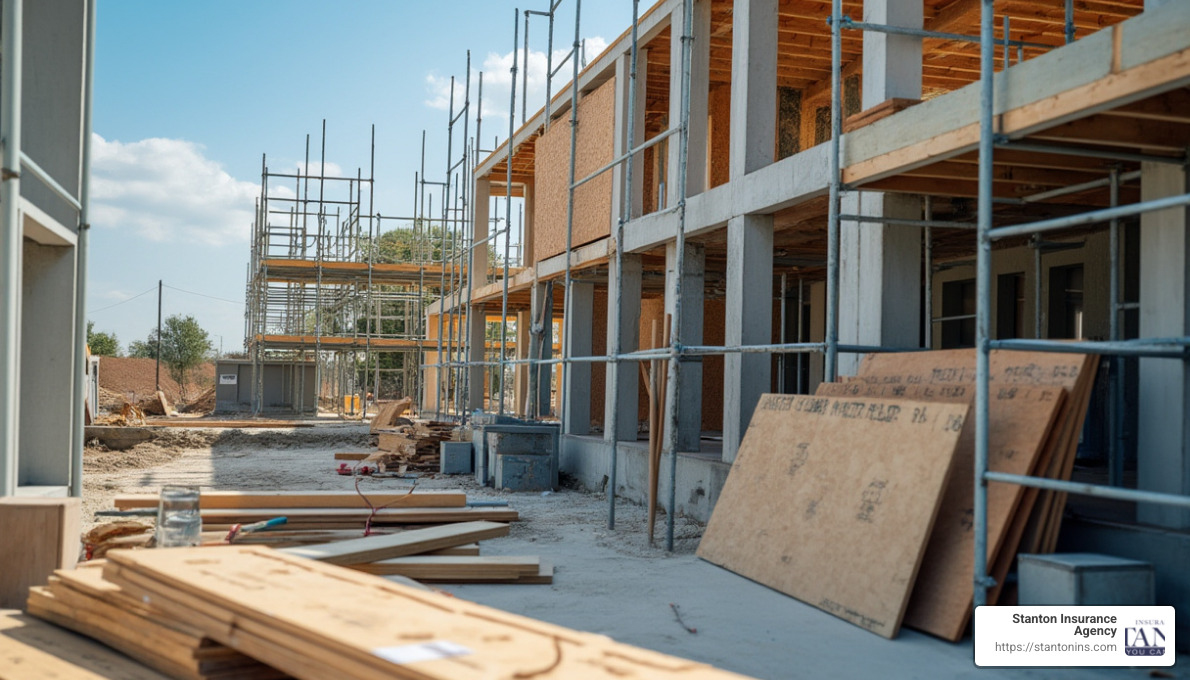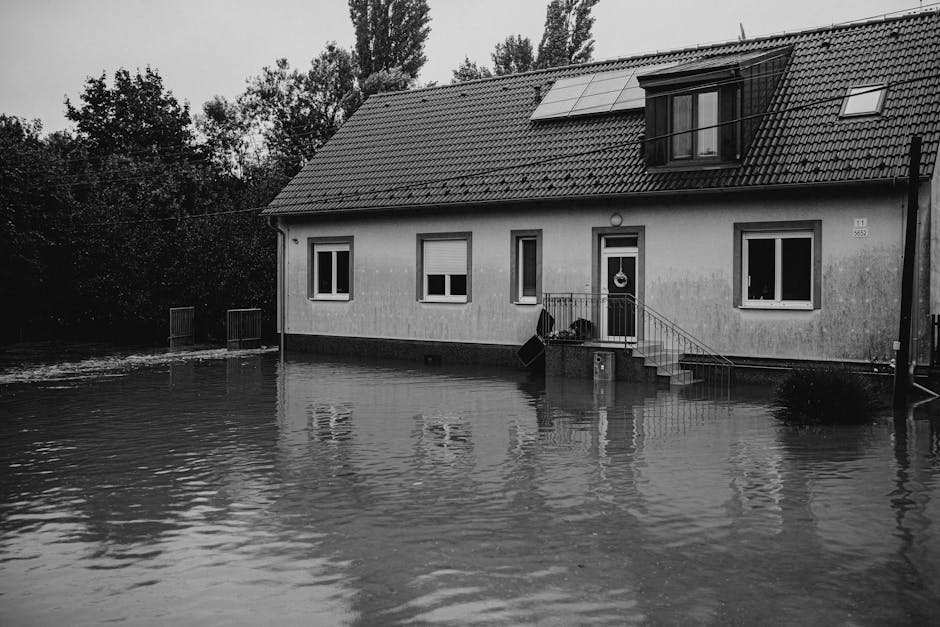Does Builders Risk Insurance Cover Flood? Top Insights 2025
Does builders risk insurance cover flood? Not typically. In most cases, builder’s risk insurance excludes flood damage, necessitating separate flood insurance. Here’s what you need to know:
- Flooding is a common exclusion in builder’s risk policies, often necessitating additional coverage.
- Separate flood insurance can be added, but it increases the deductible, commonly starting at $25,000.
Understanding whether builder’s risk insurance covers flood is crucial for homeowners and businesses alike. This coverage is vital to protect your construction project from unforeseen losses due to water damage. As someone who has worked in the insurance industry for years, I, Geoff Stanton, am well-versed in the intricacies of builder’s risk insurance and the importance of flood coverage.
At Stanton Insurance Agency, we specialize in tailoring insurance solutions to meet your specific needs. We take pride in guiding you through the complexities of insurance coverage, ensuring your valuable investments remain protected. Keep reading to find more about builder’s risk insurance and how to safeguard against flood-related losses.
Find more about does builder’s risk insurance cover flood:
– what does builders risk cover
– builder’s risk insurance policy
– construction insurance
What is Builder’s Risk Insurance?
Builder’s risk insurance is a special type of property insurance designed to cover buildings and structures under construction. This insurance is essential for both new construction and renovation projects.
Coverage Scope
Builder’s risk insurance generally covers:
- Materials: This includes all the building materials on-site, whether they are installed or not.
- Equipment: Tools and machinery used for construction are protected.
- Temporary Structures: Items like scaffolding, temporary storage, and even trailers may be covered.
Construction Projects
This insurance is vital for anyone involved in construction projects. It protects against losses due to events like fire, theft, and certain types of water damage. However, it usually does not cover flooding unless a separate endorsement is added.
Why It’s Important
Imagine you’re building a new office. Halfway through, a storm damages your construction materials. Without builder’s risk insurance, the financial loss could be significant.
Key Points:
- Comprehensive Coverage: Protects against many risks during construction.
- Customizable: Policies can be tailored to meet specific project needs.
- Essential for Contractors: Ensures that projects can continue smoothly without financial setbacks.
In summary, builder’s risk insurance is a crucial safeguard for construction projects. It covers materials, equipment, and structures, ensuring that unexpected events don’t derail your progress. As you plan your construction project, consider the benefits of this insurance to protect your investment.
Does Builder’s Risk Insurance Cover Flood?
When it comes to builder’s risk insurance, one of the most common questions is: Does builder’s risk insurance cover flood? The short answer is usually no. Flooding is often a primary exclusion in these policies, meaning damage caused by floodwaters isn’t covered unless specific steps are taken.
Understanding Flood Exclusions
Most builder’s risk insurance policies exclude coverage for floods. A “flood” is typically defined as a temporary condition where water inundates normally dry land. This can happen due to:
- Overflow of inland or tidal waters
- Unusual or rapid accumulation of surface water
- Mudslides or mudflows caused by flooding
These exclusions are crucial to understand, especially if your construction site is in an area prone to heavy rain or rapid runoff. For instance, during monsoon seasons, a sudden downpour might cause water to accumulate quickly, leading to what insurers define as a flood.
Adding Flood Coverage to Builder’s Risk Insurance
To protect against flood damage, you can add flood coverage as an optional endorsement to your builder’s risk insurance. This is a separate coverage that comes with its own considerations:
- Higher Deductibles: Adding flood insurance often means a higher deductible. The minimum is usually around $25,000, but it can vary by insurer.
- Cost Considerations: While adding flood coverage increases the premium, it can be a financially sound decision, especially if your project is in a flood-prone area.
- Specific Scenarios: Consider scenarios like broken water lines or unexpected heavy rains that lead to flooding. These are common causes of flood claims on construction sites.
In summary, while builder’s risk insurance doesn’t typically cover flooding, adding a flood endorsement can provide much-needed protection. It’s essential to weigh the costs and benefits, especially if your construction site faces potential flood risks.
Common Exclusions in Builder’s Risk Insurance
While builder’s risk insurance covers many potential losses during construction, it has specific exclusions that are important to understand. Knowing what isn’t covered can help you plan better and avoid unexpected expenses.
Flooding and Earthquakes
Flooding and earthquakes are two significant natural events often excluded from standard builder’s risk policies.
Flooding is typically not covered, meaning any damage from floodwaters, whether from overflowing rivers or rapid surface water accumulation, requires separate flood insurance. This is crucial if your project is in a flood zone. Adding flood coverage can involve higher deductibles, starting at around $25,000, but it’s a wise investment in flood-prone areas.
Earthquakes also require separate insurance. If you’re building in earthquake-prone areas, like Northern California, securing earthquake coverage is essential to protect your investment.
Employee Theft and Faulty Workmanship
Employee Theft is another exclusion. Builder’s risk policies generally cover theft from third parties, but not if an employee or subcontractor is involved. Implementing strict screening processes and background checks can mitigate this risk.
Faulty Workmanship refers to poor design, materials, or construction practices. While the policy won’t cover the cost of replacing faulty work, it will cover damage resulting from it. For instance, if poor electrical work causes a fire, the damage from the fire is covered, but not the cost to fix the electrical work itself. Consider a contractor professional liability policy to cover these gaps.
Man-Made Events
Certain extreme man-made events are excluded due to their high-risk nature:
- Acts of Terror
- Acts of War
- Nuclear Accidents
These are typically not covered by builder’s risk insurance. If your project is at risk of such events, consult your insurer about specialized coverage options.
Understanding these exclusions helps you anticipate potential risks and make informed decisions about additional coverage. In the next section, we’ll explore proactive steps to mitigate flood risks in construction projects.
Steps to Mitigate Flood Risks in Construction Projects
Flood risks can pose serious threats to construction projects. But with the right steps, you can significantly reduce these risks and protect your investment. Here are some best practices and insurance tips to help you prepare.
Best Practices for Contractors
- Proactive Measures: Start by identifying potential flood risks during the planning phase. Use flood maps and historical data to assess the likelihood of flooding in your area.
- Site Planning: Design your site with flooding in mind. Lift structures where possible and ensure that critical equipment is stored above potential flood levels.
- Drainage Systems: Install effective drainage systems to manage rainwater and prevent water accumulation. Regularly inspect these systems to ensure they remain clear and functional.
- Waterproofing: Use waterproof materials and techniques to protect structures, especially basements and foundations, from water damage.
- Site Elevation: If feasible, lift the entire construction site to reduce the risk of floodwater reaching your structures.
- Emergency Response Plans: Develop and practice emergency response plans. Ensure that all workers know how to respond in the event of a flood warning.
Insurance Tips for Builders
- Reviewing Policies: Carefully review your builder’s risk insurance policy to understand what is and isn’t covered. Pay special attention to exclusions related to water damage.
- Understanding Exclusions: Know that standard builder’s risk policies typically exclude flood damage. Consider purchasing additional flood insurance, especially if your project is in a flood-prone area.
- Consulting with Insurers: Talk to your insurance agent about your specific needs. They can help you understand the risks and recommend the best coverage options.
By implementing these proactive measures and understanding your insurance options, you can better protect your construction project from flood risks. Next, we’ll address some frequently asked questions about builder’s risk insurance and flood coverage.
Frequently Asked Questions about Builder’s Risk Insurance and Flood Coverage
What types of water damage are covered under builder’s risk insurance?
Builder’s risk insurance typically covers certain types of water damage, but it’s important to know what’s included. Generally, it protects against damage from broken pipes or plumbing issues, provided the utilities meet code standards and the damage isn’t due to maintenance failures. However, flooding is usually excluded. This means if rainwater accumulates and causes damage, it might not be covered unless you have specific flood insurance.
To avoid surprises, always check your policy details and speak with an insurance agent to clarify what water-related events are covered.
How can I add flood coverage to my builder’s risk policy?
Adding flood coverage to your builder’s risk policy often involves purchasing a separate endorsement or policy. Here are steps to consider:
- Consult Your Insurer: Talk to your insurance provider about adding flood coverage. They can guide you on available options and the process to add this coverage.
- Evaluate Costs: Be aware that adding flood coverage can result in higher premiums and deductibles. For instance, the minimum deductible might start at $25,000, depending on the insurer.
- Consider Project Location: If your construction site is not in a designated flood zone, flood insurance might be more affordable. However, always weigh the costs against the potential risk.
Adding flood coverage can provide peace of mind and protect your project from unforeseen water damage.
What should I do if my construction site is in a flood-prone area?
If your construction site is in a flood-prone area, taking proactive steps is crucial:
- Assess Flood Risks: Use flood maps and historical data to understand the likelihood of flooding in your area. This helps in planning and risk mitigation.
- Purchase Flood Insurance: Given the high risk, obtaining flood insurance is essential. This can be through the National Flood Insurance Program (NFIP) or private insurers.
- Implement Mitigation Measures: Lift structures, install effective drainage systems, and use waterproof materials to minimize potential damage.
- Develop Emergency Plans: Have a clear emergency response plan in place. Ensure that all site workers are trained on how to respond during a flood event.
By taking these steps, you can better safeguard your construction project and ensure you have the necessary coverage in place.
Conclusion: Does Builders Risk Insurance Cover Flood
In summary, understanding your builder’s risk insurance coverage is crucial, especially when it comes to potential flood damage. While standard policies often exclude flooding, adding a flood endorsement can fill this gap, protecting your construction projects from unforeseen water-related events.
At Stanton Insurance Agency, we are committed to providing trusted protection for your valuable assets. Whether you’re building a new structure or renovating an existing one, our team can help you navigate the complexities of insurance options. We offer comprehensive solutions tailored to meet your specific needs, ensuring you have the right coverage in place.
The right insurance coverage not only safeguards your investments but also provides peace of mind. Don’t leave your project vulnerable to unexpected disasters. Partner with us to secure a policy that covers all bases, including potential flood risks.
For more detailed information on how we can protect your construction projects, visit our business insurance page. Let Stanton Insurance Agency be your trusted partner in safeguarding your projects and ensuring a successful build.




